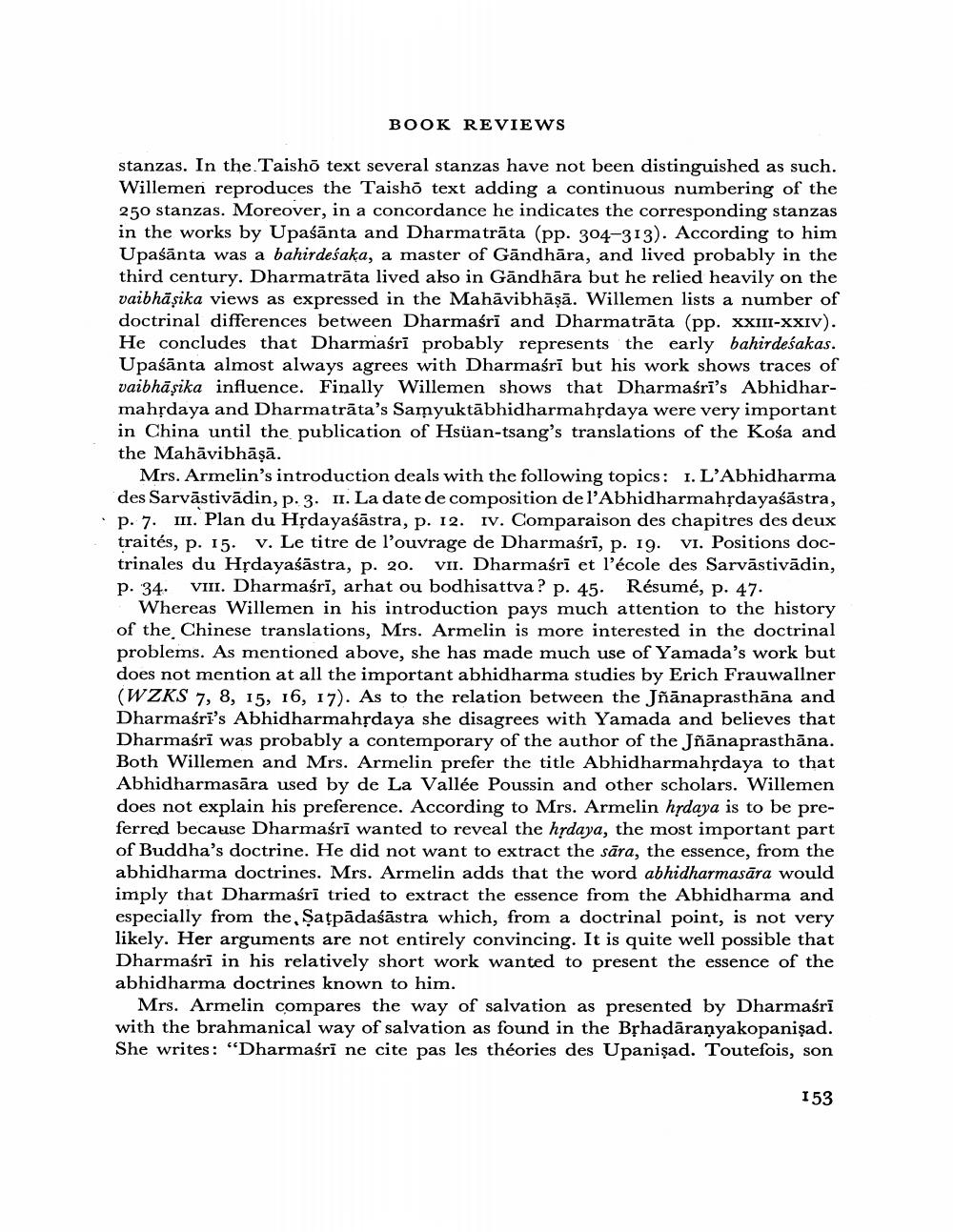Book Title: Book Reviews Author(s): J W De Jong Publisher: J W De Jong View full book textPage 3
________________ BOOK REVIEWS stanzas. In the Taishō text several stanzas have not been distinguished as such. Willemen reproduces the Taisho text adding a continuous numbering of the 250 stanzas. Moreover, in a concordance he indicates the corresponding stanzas in the works by Upaśānta and Dharmatrāta (pp. 304–313). According to him Upaśānta was a bahirdeśaka, a master of Gāndhāra, and lived probably in the third century. Dharmatrāta lived also in Gāndhāra but he relied heavily on the vaibhāșika views as expressed in the Mahāvibhāṣā. Willemen lists a number of doctrinal differences between Dharmaśrī and Dharmatrāta (pp. XXIII-XXIV). He concludes that Dharmasri probably represents the early bahirdeśakas. Upaśānta almost always agrees with Dharmaśrī but his work shows traces of vaibhāșika influence. Finally Willemen shows that Dharmasri's Abhidharmahsdaya and Dharmatrāta's Samyuktābhidharmahsdaya were very important in China until the publication of Hsüan-tsang's translations of the Kośa and the Mahāvibhāṣā. Mrs. Armelin's introduction deals with the following topics: 1. L'Abhidharma des Sarvāstivādin, p. 3. 11. La date de composition de l'Abhidharmahỉdayaśāstra, . p. 7. III. Plan du Hşdayaśāstra, p. 12. Iv. Comparaison des chapitres des deux traités, p. 15. v. Le titre de l'ouvrage de Dharmaśrī, p. 19. VI. Positions doctrinales du Hşdayaśāstra, p. 20. VII. Dharmaśrī et l'école des Sarvāstivādin, p. 34. VIII. Dharmaśrī, arhat ou bodhisattva? p. 45. Résumé, p. 47. Whereas Willemen in his introduction pays much attention to the history of the Chinese translations, Mrs. Armelin is more interested in the doctrinal problems. As mentioned above, she has made much use of Yamada's work but does not mention at all the important abhidharma studies by Erich Frauwallner (WZKS 7, 8, 15, 16, 17). As to the relation between the Jñānaprasthāna and Dharmasri's Abhidharmahşdaya she disagrees with Yamada and believes that Dharmasri was probably a contemporary of the author of the Jñānaprasthāna. Both Willemen and Mrs. Armelin prefer the title Abhidharmahsdaya to that Abhidharmasāra used by de La Vallée Poussin and other scholars. Willemen does not explain his preference. According to Mrs. Armelin hrdaya is to be preferred because Dharmasri wanted to reveal the hşdaya, the most important part of Buddha's doctrine. He did not want to extract the sāra, the essence, from the abhidharma doctrines. Mrs. Armelin adds that the word abhidharmasāra would imply that Dharmasri tried to extract the essence from the Abhidharma and especially from the, Şațpādaśāstra which, from a doctrinal point, is not very likely. Her arguments are not entirely convincing. It is quite well possible that Dharmasri in his relatively short work wanted to present the essence of the abhidharma doctrines known to him. Mrs. Armelin compares the way of salvation as presented by Dharmaśrī with the brahmanical way of salvation as found in the Bșhadāraṇyakopanişad. She writes: "Dharmasri ne cite pas les théories des Upanişad. Toutefois, son 153Page Navigation
1 2 3 4 5 6 7 8
